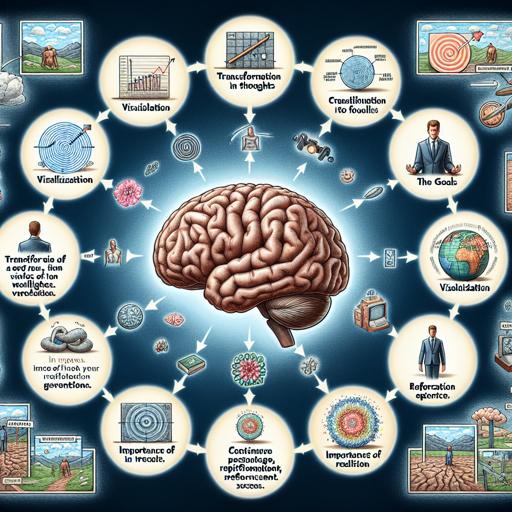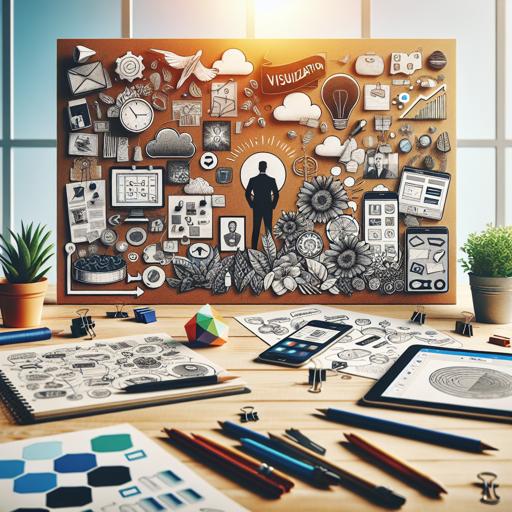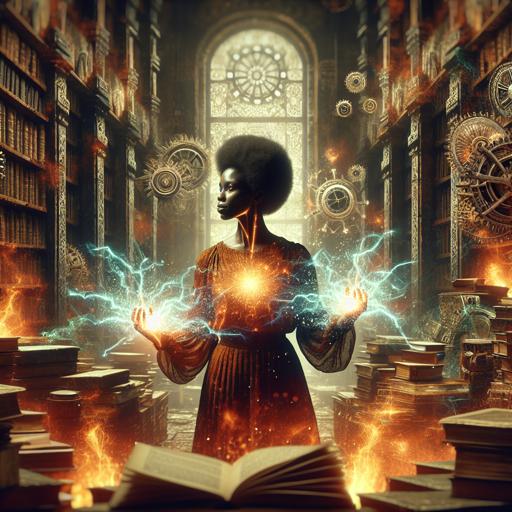In today’s fast-paced world, where information is abundant and attention spans are fleeting, harnessing the power of visualization has become more essential than ever. Visualization transforms complex data into intuitive graphics, enabling us to comprehend and communicate intricate ideas swiftly and effectively.
Whether in business, education, or personal development, visual tools help us unlock new insights and drive impactful decisions. By tapping into our innate ability to process visual information, we can bridge gaps in understanding and foster a deeper connection with our audience. Join us as we explore the transformative potential of visualization in various aspects of life and work.
Understanding the science behind visualization: how it works and why it’s effective

In the symphony of human potential, visualization is akin to a maestro, orchestrating the harmonious blend of mental imagery, perception, and emotion to create compelling narratives within the mind. This cognitive phenomenon, often revered for its profound impact on personal and professional development, functions as a bridge between intention and realization.
What’s astounding is the brain’s ability to blur the line between imagined experience and reality, effectively preparing the mind and body for future encounters. When you close your eyes and vividly picture achieving a goal, it’s not merely daydreaming; it is the deliberate act of controlling neural patterns. This act of painting mental images primes neural pathways, enhancing the likelihood of physical manifestation.
Harnessing the power of visualization involves a sophisticated interplay between the conscious and subconscious minds, crafting scenarios as if etching them into the cerebral cortex. It’s not just about seeing; it involves evoking sensory details, emotions, and context to foster a believable and inspiring scenario.
For instance, an athlete might imagine the sensation of wind rushing past as they sprint to victory, invoking the adrenaline and tension of competition to align their psyche with success. This sort of mental rehearsal strengthens neural networks, boosting confidence and resilience while reducing anxiety. Through diligent practice, visualization evolves from an abstract idea into a robust mental rehearsal, akin to staging a dress rehearsal for life’s significant events.
The effectiveness of visualization is amplified by the 'law of attraction’, where focused thoughts emit a magnetic pull towards tangible outcomes. This principle suggests that by nurturing a vivid mental movie, individuals not only set the stage for success but also attract the resources and opportunities necessary to actualize their aspirations.
Whether one is striving for career advancement, overcoming personal challenges, or seeking creative inspiration, visualization is a versatile tool that enhances focus, motivation, and clarity. In essence, this cognitive strategy unlocks a world where imaginations become blueprints for success, reshaping perceptions to turn visions into reality. The power of visualization lies not just in daydreaming, but in harnessing the mind’s capabilities to bring forth one’s boldest ambitions.
Techniques and tools for effective visualization: from vision boards to digital apps

In the realm of personal development and goal-setting, harnessing the power of visualization has been likened to wielding a paintbrush to craft the canvas of your dreams. Yet, unlike the solitary artist of old, today’s visionaries are equipped with a toolkit of modern aids, bridging the gap between imagination and execution with elegance and precision. Traditional vision boards, the beloved relics of the self-help world, offer an analog sanctuary where dreams are glued.
The tactile process of assembling images and words onto a physical board is more than mere craft; it’s a meditation in materializing intentions. As hands work in tandem with the mind, there is a kinetic synergy that reinforces commitment, turning abstract aspirations into palpable artefacts of willpower.
However, the evolving digital landscape has introduced an exhilarating spectrum of tools that significantly amplify this endeavor. Tech-savvy individuals now gravitate towards an array of digital apps designed to refine and expand the visualization process.
These advanced platforms are not just electronical echoes of their physical predecessors; they offer dynamic functionality that enhances goal visualization. With seamless integration across devices, customizable features, and tailored reminders, digital tools facilitate an environment where goals are not only set but actively nurtured. Elegant software with interactive interfaces transforms static images into dynamic, evolving plans, providing users with real-time updates, and making self-improvement a perpetual, engaging journey.
By blending the tactile satisfaction of traditional methods with the precision and accessibility of modern technology, this new wave of visualization techniques paves a pathway for success that is bound only by the horizon of one’s creativity.
Visualization in personal development: achieving goals and enhancing performance

Imagine waking up to your favorite song with a morning sunbeam peeking through the curtains, gently inviting you to step into the best version of yourself. You’re not only kick-starting your day with optimism but also practicing one of the most underrated tools in personal transformation: visualization.
Picture this mental image on repeat, powering your ambition like a potent espresso charged with focus and energy. Harnessing this imaginative prowess in personal development is like learning the wizardry of transforming dreams into reality. By envisioning your goals with vibrant details, not only do you map the road ahead, but you also get a head start by psychologically experiencing the journey before it even begins.
This powerful cognitive tool is not reserved for artists or athletes; it’s a universal key that opens the door to unparalleled performance and goal achievement. Consider Stephen, an ambitious young professional determined to lead his team to new heights.
Each morning, he envisions himself steering strategic meetings, negotiating successful deals, and receiving accolades from delighted clients. This mental rehearsal acts as a secret rehearsal of reality, reducing the element of surprise and anxiety while fortifying his confidence. It is as if his mind crafts a narrative where triumph is the only possible conclusion, thus enhancing his performance with every imagery-rich session.
Visualization plants seeds of self-assurance in the fertile ground of the subconscious, where they grow into sturdy oaks of achievement and satisfaction. In this realm, success does not just happen; it is deliberately orchestrated in the theater of the mind.
The role of visualization in professional settings: boosting creativity and problem-solving
In the bustling landscape of professional environments, where every cog in the machine seems obsessed with efficiency and precision, visualization emerges as the unsung hero of creativity and inventive problem-solving. Harnessing the power of visualization can transform monotonous strategic meetings into vibrant brainstorming sessions, redirecting the focus from endless spreadsheets to awe-inspiring visual frameworks. Imagine trying to assemble a jigsaw puzzle with only the written instructions to guide you – challenging and time-consuming, right?
Visualization, in contrast, presents a vivid picture that not only clarifies the end goal but also sets the mind free to explore unconventional paths, ushering in the age of innovation within even the most rigid corporate structures. Take, for example, the realm of product development.
Sketching out ideas, using mind maps, and creating mood boards can significantly enhance the creative process. A design team utilizing visual brainstorming can quickly generate and iterate ideas, pinpoint potential flaws, and refine concepts in ways purely textual approaches might overlook. Visual thinking extends beyond mere aesthetics; it’s about cultivating a rich tapestry of insights, fostering collaboration, and bridging diverse perspectives into a unified vision.
By leveraging visualization, professionals can unravel complex problems with the dexterity of a magician pulling the elusive solution from their hat, turning what once seemed like insurmountable challenges into opportunities ripe for exploration and conquest. Moreover, infusing visualization into problem-solving can reignite the innate curiosity and imagination that often lie dormant amidst the daily grind.
When data is presented visually, such as through interactive analytics dashboards or innovative infographics, it becomes not only more digestible but also sparks a deeper engagement with the material. Teams can suddenly see patterns and trends that were previously hidden in plain sight. This visual enlightenment empowers individuals to think outside the traditional boundaries, encouraging a fluidity of thought that propels not just individual success but collective breakthroughs.
In essence, embracing visualization in the professional arena is akin to wielding a maestro’s baton, conducting the symphony of creativity and logic to orchestrate unprecedented achievements.
Overcoming challenges in visualization: common pitfalls and how to avoid them
In the realm of data, visualization stands as both an art and a science, enabling us to communicate complex information with clarity and flair. Yet like any powerful tool, visualization can lead us astray if not handled with care.
The common pitfalls in creating effective visual displays can turn an insightful chart into a misleading masterpiece. One of the most frequent blunders is drowning in data density, which can overwhelm the viewer. Avoid this trap by prioritizing clarity over clutter.
Opt for simplicity in your visual designs, stripping them down to their essence without losing the story behind the numbers. Color is another seductive siren; used judiciously, it highlights key points, but overuse can bewilder rather than guide. By harnessing the subtle power of color, you can steer your audience’s gaze to where it truly belongs.
Cleverly balanced visualizations transform raw data into engaging narratives. It is essential to guard against assumptions that your audience will interpret your visual intentions correctly.
A common oversight is neglecting the need for intuitive labels and explanatory titles. Provide context through thoughtful annotations and legends that simplify interpretation without patronizing your audience.
Consider, too, the scale—both in terms of axes and scope. Misrepresenting data through skewed scales or inappropriate intervals can undermine trust, casting doubt on your integrity as a data storyteller. Selecting the correct type of chart for your data is a crucial decision in harnessing visualization’s power.
A pie chart might convey proportions effectively, while a line graph can illuminate trends over time; knowing their strengths prevents muddled messages. Moreover, remember that iterating your visualization approach is just as important as the initial creation. Embrace feedback from varied perspectives to refine and perfect your visuals. Opt for user tests to ascertain whether viewers glean the intended insights at a glance. Such diligence will ensure that your visualizations not only inform but also delight. By adopting this strategic approach to visualization, you transcend mere data presentation to craft compelling insights. With foresight and finesse, you will sidestep the challenges that could otherwise obscure the data’s true narrative, and instead reveal its illuminating stories.
Nasza rekomendacja wideo
Podsumowanie
In summary, harnessing the power of visualization can significantly enhance personal and professional growth. By creating mental images of goals and desired outcomes, individuals can improve focus, boost motivation, and foster a positive mindset. Whether used in sports, business, or personal development, visualization is a powerful tool that can lead to greater success and fulfillment in various aspects of life.
Najczęściej zadawane pytania
What are the key benefits of using visualization techniques in personal and professional development?
Visualization techniques enhance personal and professional development by improving focus, boosting motivation, and facilitating goal achievement through mental rehearsal and positive imagery.
Sure, please provide the question you’d like answered.
How can visualization improve goal-setting and increase the likelihood of achieving desired outcomes?
Visualization can enhance goal-setting by creating a clear mental image of success, thereby boosting motivation, focus, and confidence, which increases the likelihood of achieving desired outcomes.
Sure, please provide the question you’d like me to answer.
What are some effective visualization exercises or practices that can be incorporated into daily routines?
Effective visualization exercises for daily routines include guided imagery, vision boards, and mental rehearsals of goals or desired outcomes.
Of course! Please provide the question you’d like me to answer.
How does visualization impact mental health and stress management?
Visualization can positively impact mental health and stress management by promoting relaxation, reducing anxiety, and enhancing emotional resilience through the mental rehearsal of calming and positive scenarios.
Of course! Please provide the question you’d like me to answer.
In what ways can visualization be used to enhance learning and memory retention?
Visualization can enhance learning and memory retention by transforming abstract concepts into concrete images, thereby engaging multiple cognitive pathways and making information more accessible and memorable.
Sure, please provide the question you’d like me to answer.
How can businesses and organizations leverage visualization to improve team performance and innovation?
Businesses and organizations can leverage visualization to improve team performance and innovation by using visual tools to simplify complex data, enhance communication, and foster collaborative problem-solving.
